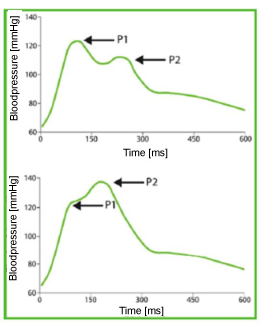After determining the ABI, the brachial and aortic augmentation index (AIx) (converted using a transfer function) can be determined in addition to the different pulse wave velocities (PWV) and the central blood pressure. These parameters are a measure of arterial stiffness. The augmentation index is a recognized parameter for evaluating arterial stiffness. Oscillations generated by the pulse wave at diastolic and suprasystolic pressure levels are recorded by the brachial cuff in conjunction with a highly sensitive vibration sensor.
The first peak (P1) results from the ejection of the blood from the heart. This wave is reflected at branches and constrictions
, and primarily at the aorta bifurcation. The reflection is indicated by the second peak (P2).
As reflected in the illustrations, the curve changes with advancing age. This change is an expression of increased arterial stiffness. The stiffer the arteries, the quicker the pulse wave travels within the vessel. The reflected wave arrives earlier in P1. Therefore, if positive augmentations occur in adults, a reduced arterial elasticity can be assumed.

Pressure curves at different stages of life: Picture above: Normal pressure curve in adulthood, picture below: pressure curve in late life stage
The augmentation index represents the relationship of augmentation to pulse pressure. Augmentation as a function of pulse wave reflection is largely dependent on the pulse wave velocity, which in turn is dependent on arterial elasticity.





